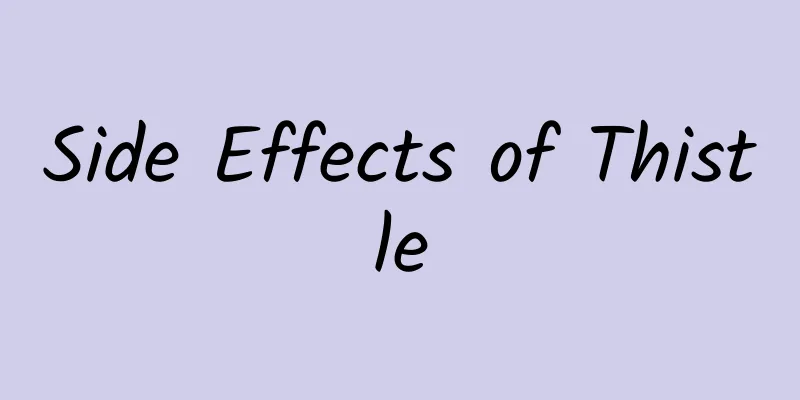Side Effects of Thistle

|
Although we all like to look at things from a positive perspective, it cannot be denied that everything has two sides. One side is beneficial, the other side is harmful. The same principle applies to food. Only by understanding their shortcomings can we use them better. The same principle applies to people. Only when we understand each other can we get along better. In fact, it is normal for everyone to see the bright side of things, but they do not understand and contact the harmful side. The consequences of this are also very serious. For example, we often see on TV that when eating these foods, people do not understand their harmful effects beforehand and end up being poisoned after eating them. Therefore, it is very important to understand the deficiencies in food. So what are the side effects of thistle? Thistle is a plant of the genus Cirsium in the Asteraceae family. It is distributed in North Korea, Japan, Taiwan Island, as well as Jiangsu, Hebei, Shandong, Shaanxi, Jiangxi, Yunnan, Hunan, Fujian, Hubei, Guizhou, Guangxi, Guangdong, Sichuan, Zhejiang and other places in mainland China. It grows in areas with an altitude of 400 to 2,100 meters, generally in wastelands, grasslands, hillside forests, roadsides, thickets, fields, forest edges and streams. It is cultivated artificially for medicinal purposes. The flower language is cautious, rigorous, steady and silent love. Also known as great thistle, prickly thistle, and mountain radish. Perennial herb with numerous fleshy conical roots. The stem is erect, 50-100 cm high, branched, and has white silky hairs at the base. The whole plant is used as medicine to treat heat-induced bleeding, the leaves can treat blood stasis, and can be used externally to treat ulcers. The whole plant contains bioalkali and volatile oil. Fresh leaves contain citric acid. Its root can be used as medicine to cool blood, stop bleeding, remove blood stasis and reduce swelling. Avoid using medication; People with spleen and stomach deficiency and coldness but no blood stasis should not take it. ① "Pin Hui Jing Yao": "Avoid touching iron objects." ② "Ben Cao Jing Shu": "It is not good for weak stomach diarrhea and extreme blood deficiency, weak spleen and stomach and loss of appetite." ③ "Ben Cao Hui Yan": "It is not good for qi deficiency." Thistle: sweet, cool, non-toxic. Functions and indications: Treats hematemesis, epistaxis, hematuria, hematuria, metrorrhagia, leucorrhea, intestinal wind, intestinal abscess, carbuncle, swelling and toxins, and furuncle. 1. Cooling blood and stopping bleeding: used for bleeding caused by blood heat, such as hematemesis, epistaxis, metrorrhagia, hematuria, etc. It can be used alone or in combination with other hemostatic drugs. 2. Dissipate blood stasis, detoxify and eliminate carbuncle: Used for carbuncle caused by heat toxin, taken orally or mashed fresh product for external application. Dosage and Administration: For internal use: decoct in water, 1.5-3 qian (1-2 liang for fresh), mash into juice or grind into powder. For external use: mash and apply or mash and apply juice. Contraindications: People with spleen and stomach deficiency and coldness without blood stasis should not take it. It is not suitable for people with spleen and stomach deficiency, no blood stasis, or extreme blood deficiency. Medicinal value Main ingredients: The whole plant contains bioalkali and volatile oil. The roots contain taraxasterol acetate, stigmasterol, a-amyrin, B-amyrin, and B-sitosterol. The fresh leaves contain 2.1% chelidonin. The roots contain volatile oil, which contains four unsaturated hydrocarbons, namely monotaxene, dihydromonotaxene, tetrahydromonotaxene, and hexahydromonotaxene. The quality of food not only affects the body's reaction after eating, but also indirectly affects people's mood. Therefore, everyone should remember the side effects of thistle introduced above. Otherwise, if you eat it at the wrong time or eat it with other incompatible foods, the consequences will be disastrous. Only by fully understanding the benefits and harms of food can people who eat it feel at ease. |
Recommend
It's exciting to listen to! People south of this line in China have hope for winter
Recently, the news that "three communities i...
IATA: Air passenger traffic in Asia Pacific increased by 125.6% year-on-year in the first half of 2023
In the first half of 2023, global revenue passeng...
The efficacy and function of bamboo orchid
Bamboo orchid is a common Chinese medicinal mater...
Cyber Monday: Evolution of Cyber Monday Promotions – Data View
Cyber Monday is the beginning of the week, which...
The "SpongeBob SquarePants" of the ceramic world, this ceramic is both light and heat-retaining!
Produced by: Science Popularization China Author:...
Can American ginseng and mutton be eaten together?
American ginseng is cool in nature, but mutton is...
The efficacy and function of Lingsha
Lingsha is a traditional Chinese medicine. It has...
The efficacy and function of Paulownia bark
In today's society, health preservation seems...
Lard, does it protect or harm the cardiovascular system? People who eat it often should read this!
Speaking of lard, the first thing that comes to m...
White atractylodes, white peony root, and white Poria cocos for removing spots
Atractylodes macrocephala, white peony root, and ...
How do you know if your spine is bent? Is there any hope for a bent spine?
Not long ago, a hot search on Weibo made many peo...
Effects and functions of Tetrapanax tetragonum
The world is full of wonders, and Chinese medicin...
The efficacy and function of hibiscus leaves
Since Chinese medicine has fewer side effects, mo...
He wrote three articles to promote the formulation of China's first "Seed Law" | Museum Exploration Notes
Editor’s Note: On May 30, the Chinese Scientists ...
Huoxiang Zhengqi Water
Huoxiang Zhengqi Water is a commonly used medicin...









